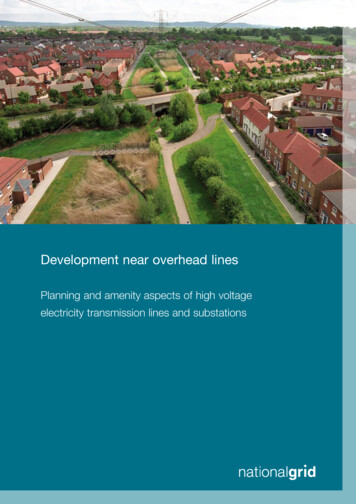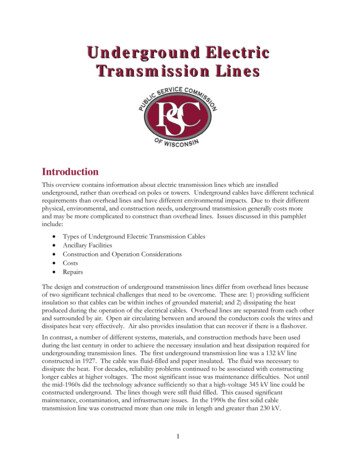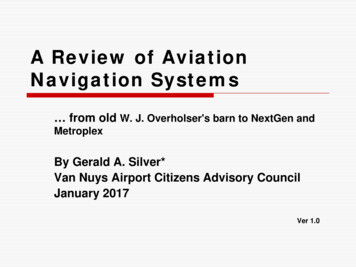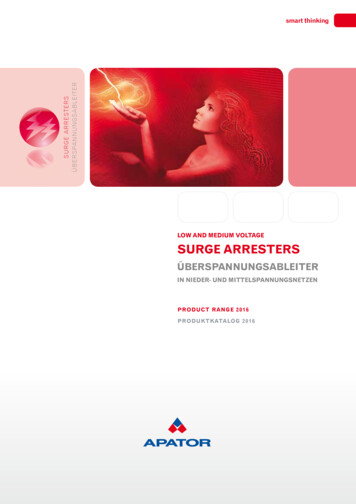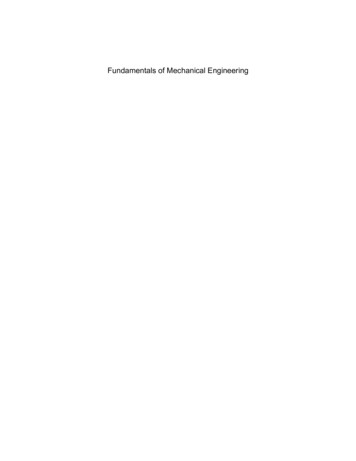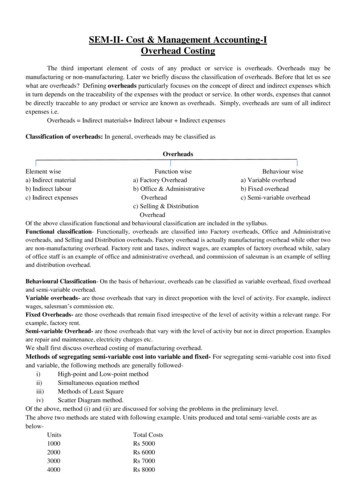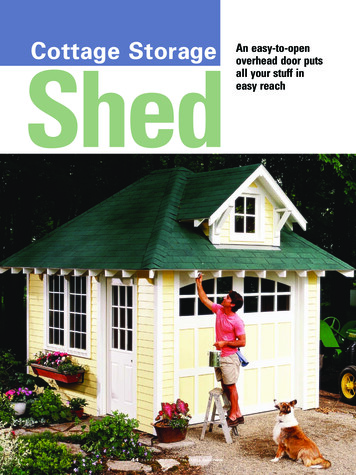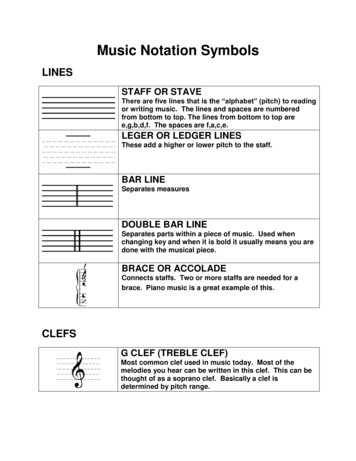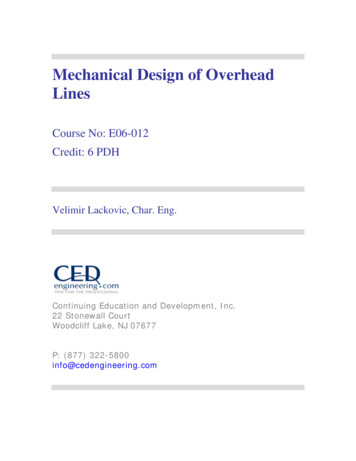
Transcription
Mechanical Design of OverheadLinesCourse No: E06-012Credit: 6 PDHVelimir Lackovic, Char. Eng.Continuing Education and Development, Inc.22 Stonewall CourtWoodcliff Lake, NJ 07677P: (877) 322-5800info@cedengineering.com
Mechanical Design of Overhead LinesElectric power can be carried either by underground cables or overhead transmissionand distribution lines. The underground cables are not typically used for powertransmission due to two reasons.1. Power is carried over long distances to remote load centres. Obviously, theinstallation costs for underground transmission will be huge.2. Electric power has to be transferred at high voltages for economic reasons. It is verydifficult to achieve proper insulation to the cables to withstand higher pressures.Therefore, power transfer over long distances is done by using overhead lines. Withthe power demand increase and consequent voltage level rise, power transmission byoverhead lines has assumed significant importance.Nevertheless, an overhead line is subjected to various weather conditions and otherexternal interferences. This asks for the use of adequate mechanical safety factors inorder to ensure the continuity of line operation. Typically, the strength of the line needsto be such so it can withstand the worst probable weather conditions. This coursefocuses on the different aspects of mechanical design of overhead lines.Overhead Line Main ComponentsAn overhead line may be used to transfer or distribute electric power. The properoverhead line operation depends to a big extent upon its mechanical design. Whileconstructing an overhead line, it has to be verified that line mechanical strength is suchso as to provide against the most probable weather conditions. Typically, the mainelements of an overhead line are:-Conductors which transfer power from the sending end station to the receivingend station.-Supports which may be poles or towers. They keep the conductors at anappropriate level above the earth.
-Insulators that are connected to supports and insulate the conductors from theearth.-Cross arms which give support to the insulators.-Miscellaneous elements such as phase plates, danger plates, surge arrestors,etc.The overhead line operation continuity depends upon the judicious selection of aboveelements. Hence, it is beneficial to have detailed discussion on them.Overhead Line Conductor MaterialsThe conductor is one of the crucial items as most of the financial outlay is invested forit. Hence, correct selection of conductor material and size is of significant importance.The conductor material used for transmission and distribution of electric power needsto have the following characteristics:-High tensile strength in order to sustain mechanical stresses-High electrical conductivity-Low specific gravity so that weight per unit volume is small-Low cost so that it can be used for considerable distancesAll above demands cannot be found in a single material. Hence, while choosing aconductor material for a particular application, a compromise is made between thecost and the needed electrical and mechanical characteristics.Typically used conductor materialsTypically used conductor materials for overhead lines are copper, aluminium, steelcored aluminium, galvanised steel and cadmium copper. The selection of a particularmaterial is dependant on the cost, the needed electrical and mechanicalcharacteristics and the local conditions. All conductors used for overhead lines are
typically stranded in order to increase the flexibility. In stranded conductors, there istypically one central wire and around it, successive layers of wires containing 6, 12,18, 24 . wires. Therefore, if there are n layers, the overall number of individual wiresis 3n(n 1) 1. In the production process of stranded conductors, the consecutive layersof wires are twisted or spiralled in different directions so that layers are bound together.-Copper. Copper is perfect material for overhead lines owing to its greatelectrical conductivity and increased tensile strength. It is typically used in thehard drawn form as stranded conductor. Even though hard drawing slightlydecreases the electrical conductivity, it considerably increases the tensilestrength. Copper has great current density. For example, the current carryingcapacity of copper per unit of cross-sectional area is significant. This leads totwo benefits. Firstly, smaller conductor cross-sectional area is needed andsecondly, the area offered by the conductor to wind loads is decreased. Also,this metal is homogeneous, durable and has big scrap value. There is no doubtthat copper is perfect material for electric power transmission and distribution.Nevertheless, due to its big cost and non-availability, it is not often used forthese purposes. Current trend is to use aluminium instead of copper.-Aluminium. Aluminium is cheap and light in comparison to copper but it hasconsiderably smaller conductivity and tensile strength. The relative comparisonof the two materials is as follows:o The aluminium conductivity is 60% that of copper. The lower aluminiumconductivity means that for any specific transmission efficiency, theconductor cross-sectional area must be bigger in aluminium than in copper.For the same resistance, the aluminium conductor diameter is around 1.26times the copper conductor diameter. The increased aluminium crosssection exposes a bigger surface to wind pressure and, hence, supportingtowers have to be designed for greater transverse strength. Typically, thisrequires the use of higher towers with consequence of bigger sag.o The aluminium specific gravity (2.71 gm/cc) is lower than that of copper (8.9gm/cc). Hence, an aluminium conductor has almost one-half the weight of
equivalent copper conductor. Due to this, the supporting structures foraluminium need not be made so strong as that of copper conductor.o Aluminium conductor being light is liable to bigger swings and thereforebigger cross-arms are needed.o Due to lower tensile strength and bigger co-efficient of linear expansion ofaluminium, the sag is bigger in aluminium conductors.Considering the overall characteristics that include cost, conductivity, tensile strength,weight etc., aluminium has an edge over copper. Hence, it is being predominantly usedas a conductor material. It is especially profitable to use aluminium for heavy-currenttransmission where the conductor size is big and its cost forms a significant proportionof the total cost of complete installation.-Steel-cored aluminium. Due to low tensile strength, aluminium conductors havebigger sag. This forbids their application for bigger spans and makes themunsuitable for long distance transmission. In order to improve the tensilestrength, the aluminium conductor is strengthened with a core of galvanisedsteel wires. The obtained composite conductor is known as steel-coredaluminium or ACSR (aluminium conductor steel reinforced). Steel-coredaluminium conductor has galvanised steel central core surrounded by a numberof aluminium strands. Typically, diameter of both steel and aluminium wires isthe same. Typically, the cross-section of the two metals are in the ratio of 1:6but can be modified to 1:4 in order to get more conductor tensile strength.Figure 1. presents steel-cored aluminium conductor having one steel wiresurrounded by six aluminium wires. The result of this composite conductor isthat steel core takes bigger percentage of mechanical strength while aluminiumstrands transfer the bulk of current.The steel-cored aluminium conductors have the following benefits:
AluminumSteelFigure 1. Steel-cored aluminium conductor having one steel wire surrounded by sixaluminium wireso The reinforcement with steel improves the tensile strength but at the sametime keeps the composite conductor light. Hence, steel-cored aluminiumconductors will create smaller sag and therefore longer spans can be used.o Due to smaller sag with steel-cored aluminium conductors, towers of smallerheights can be installed.-Galvanised steel. Steel has considerable tensile strength. Hence, galvanisedsteel conductors can be applied for long spans or for short line sectionsexposed to significantly high stresses due to climatic conditions. They areconsidered as very suitable in rural locations where cheapness is the mainissue. Due to steel poor conductivity and high resistance, such conductors arenot appropriate for transferring large power over a long distance. Nevertheless,they can be used to advantage for transferring a small power over a smalldistance where the size of the copper conductor desirable from economicconsiderations would be too small and therefore inappropriate for use becauseof poor mechanical strength.-Cadmium copper. The conductor material now being used in specificinstallations is copper alloyed with cadmium. An addition of 1% or 2% cadmiumto copper improves the tensile strength by roughly 50% and the conductivity isonly decreased by 15% below that of pure copper. Hence, cadmium copperconductor can be useful for extremely long spans. Nevertheless, due tocadmium high cost, such conductors will be economical only for lines of smallcross-section i.e., where the cost of conductor material is relatively small in
comparison with the support cost.Line SupportsThe supporting structures for overhead line conductors are different pole and towertypes called line supports. Typically, the line supports should have the followingcharacteristics:-Light in weight without the loss of mechanical strength-Big mechanical strength to sustain the conductor weight and wind loads etc.-Longer life span-Easy conductor accessibility for maintenance-Cheap in cost and economical to serviceThe line supports used for electric power transmission and distribution are of differenttypes including wooden poles, steel poles, RCC poles and lattice steel towers. Theselection of supporting structure for a specific case is dependent upon the line span,cross-sectional area, line voltage, cost and local circumstances.-Wooden poles. They are made of seasoned wood and are appropriate for linesof moderate cross-sectional area and of shorter spans, say up to 50 metres.Such supports are cheap, easily available, provide insulating features and,hence, are widely used for distribution applications in rural locations as aneconomical proposition. Typically, the wooden poles tend to rot below the earthlevel, causing foundation failure. In order to avoid this, the portion of the polebelow the earth level is impregnated with preservative substances like creosoteoil. Double pole arrangements of the ‘A’ or ‘H’ type are typically used (Figure2.) to obtain a bigger transverse strength than could be economically providedby means of single poles. The main disadvantages to wooden supports are :o Tendency to rot below the earth level
o Relatively smaller life (20-25 years)o Cannot be used for voltages above 20 kVo Decreased mechanical strengtho Need occasional inspectionInsulatorsCross armsSteel bracingPoles(a)(b)Figure 2. Wooden poles-Steel poles. The steel poles are typically used as a substitute for wooden poles.They have bigger mechanical strength, longer life and allow longer spans.Typically, such poles are used for distribution purposes in the cities. Thesesupports need to be galvanised or painted in order to extend their life. The steel
poles are of three types:o Rail poleso Tubular poleso Rolled steel joints-RCC poles. The reinforced concrete poles have recently become popular asline supports. They have bigger mechanical strength, longer life and allowlonger spans than steel poles. Nevertheless, they give good outlook, need littlemaintenance and have good insulating features. Figure 3 presents RCC polesfor single and double circuit. The holes in the poles allow climbing of poles andat the same time decrease the line support weight. The main issue with the useof these poles is the high transport cost owing to their heavy weight. Hence,such poles are typically produced at the site in order to avoid big transportationcost.-Steel towers. In reality, wooden, steel and reinforced concrete poles are usedfor distribution installations at low voltages, say up to 11 kV. Nevertheless, forlong distance transmission at higher voltage, steel towers are invariably used.Steel towers have bigger mechanical strength, longer life, can sustain mostsevere climatic conditions and allow the use of longer spans. The risk ofinterrupted operation due to broken or punctured insulation is significantlydecreased owing to longer spans. Typically, tower footings are earthed bydriving rods into the ground. This decreases the lightning troubles as eachtower acts as a lightning conductor. Figure 4(a) shows a single circuit tower.Nevertheless, at a moderate extra cost, double circuit tower can be provided aspresented in Figure 4(b). The double circuit has the benefit that it ensurescontinuity of supply. In situation there is breakdown of one circuit, the continuityof supply can be kept by the other circuit.
1.5 m10 m7.5 m0.35 m0.35m(a)(b)Figure 3. (a) single circuit (b) double circuitInsulatorsThe overhead line conductors need to be supported on the poles or towers in such away that conductor currents do not flow to ground through supports for example, lineconductors have to be adequately insulated from supports. This is accomplished bysecuring line conductors to supports with the help of insulators. The insulators givenecessary insulation between line conductors and supports and therefore prevent anyleakage current from conductors to ground. Typically, the insulators need to have thefollowing desirable features:
5.75 m11 m4.5 m3.35 m41.6 m12.5 m110 kV, Span 320m(a)220 kV, Span 320m(b)Figure 4. Steel towers (a) single circuit (b) double circuit-Big mechanical strength in order to sustain conductor load, wind load etc.-Big insulator material electrical resistance in order to avoid leakage currents toground.-Big insulator material relative permittivity in order that dielectric strength is high.-The insulator material needs to be non-porous, free from impurities and cracksotherwise the permittivity will be decreased.-Big ratio of puncture strength to flashover.The most typically used material for insulators of overhead line is porcelain but glass,steatite and specific composition materials are also applied to a certain extent.Porcelain is made by firing at a high temperature a mixture of kaolin, feldspar andquartz. It is mechanically stronger than glass, gives less trouble from leakage and is
less impacted by temperature changes.Insulator TypesThe proper overhead line operation depends to a significant extent upon the adequateselection of insulators. There are few insulator types but the most typically used arepin type, suspension type, strain insulator and shackle insulator.-Pin type insulators. The section of a pin type insulator is presented in Figure 5.As the name implies, the pin type insulator is linked to the pole cross-arm. Thereis a groove on the insulator upper end for housing the conductor. The conductorgoes through this groove and is bound by the annealed wire of the samematerial as the conductor. Pin type insulators are used for electric powertransmission and distribution at voltages up to 33 kV. Above operating voltageof 33 kV, the pin type insulators become too bulky and therefore uneconomical.Insulators are required to sustain both mechanical and electrical stresses. Theelectrical stress is caused by line voltage and may cause the insulatorbreakdown. The insulator electrical breakdown can happen either by flash-overor puncture. In flashover, an arc happens between the line conductor andinsulator pin (i.e., ground) and the discharge jumps across the air gaps,following shortest distance. Figure 6 presents the arcing distance (a b c) forthe insulator. In case of flash-over, the insulator will continue to act in itsadequate capacity unless extreme heat generated by the arc destroys theinsulator. In case of puncture, the discharge occurs from conductor to pinthrough the body of the insulator. When such breakdown happens, the insulatoris completely destroyed due to significant heat. In reality, proper thickness ofporcelain is provided in the insulator to prevent puncture by the line voltage.The ratio of puncture strength to flashover voltage is known as safety factor:
Groove for conductorShed or petti coatsGalvanisedsteel pinFigure 5. Pin-type insulatoraConductorbPincCross armFigure 6. Arcing distanceInsulatorLine conductorFigure 7. Suspension type ���𝑆 𝑓𝑓𝑓𝑓𝑓𝑓𝑓𝑓𝑓𝑓𝑓𝑓 𝑜𝑜𝑜𝑜 ��𝑖𝑖𝑖𝑖𝑖 ��𝑃𝑃𝑃 �𝑡𝑡𝐹𝐹𝐹𝐹𝐹𝐹𝐹𝐹ℎ 𝑜𝑜𝑜𝑜𝑜𝑜𝑜𝑜 ��𝑣It is preferable that the value of safety factor is big so that flash-over takes place beforethe insulator gets punctured. For pin type insulators, the value of safety factor is around
10.2.-Suspension type insulators. The cost of pin type insulator quickly increases asthe working voltage is increased. Hence, this insulator type is not economicalbeyond 33 kV. For high voltages ( 33 kV), it is a typical practice to usesuspension type insulators presented in Figure 7. They consist of a number ofporcelain discs connected in series by metal links in the form of a string. Theconductor is suspended at the bottom end of this string while the other end ofthe string is secured to the tower cross-arm. Each unit or disc is designed forlow voltage, say 11 kV. The number of discs in series depends upon the workingvoltage. For example, if the working voltage is 66 kV, then six discs in serieswill be needed in the string.Suspension insulator advantages are:o Suspension type insulators are cheaper than pin type insulators forvoltages above 33 kV.o Each unit or disc of suspension type insulator is made for low voltage,typically 11 kV.o Depending upon the working voltage, the required number of discs canbe connected in series.o If any disc is destroyed, the whole string does not become uselessbecause the damaged disc can be replaced by the new one.o The suspension arrangement gives line bigger flexibility. The connectionat the cross arm is such that insulator string is free to swing in anydirection and can take up the position where mechanical stresses areminimum.o In case of increased power demand on the transmission line, it is foundbetter to provide the bigger power demand by increasing the line voltagethan to provide extra set of conductors. The extra insulation needed for
the increased voltage can be easily obtained in the suspensionarrangement by adding the needed number of discs.o The suspension type insulators are typically used with steel towers.Since the conductors run below the tower grounded cross-arm, thisarrangement gives partial protection from lightning.-Strain insulators. When there is a dead end of the line or there is corner or sharpcurve, the line is subjected to bigger tension. In order to relieve the line ofexcessive tension, strain insulators are installed. For low voltage lines ( 11kV), shackle insulators are used as strain insulators. Nevertheless, for highvoltage lines, strain insulator consists of an assembly of suspension insulatorsas presented in Figure 8. The discs of strain insulators are installed in thevertical plane. When the tension in lines is exceedingly big, as at long riverspans, two or more strings are installed in parallel.BoltStrain igure 8. Strain insulators-Figure 9. Shackle insulatorsShackle insulators. The shackle insulators were used as strain insulators in thepast. These days, they are normally used for low voltage distribution lines. Suchinsulators can be used either in a horizontal position or in a vertical position.They can be directly connected to the pole with a bolt or to the cross arm. Figure9 presents a shackle insulator fixed to the pole. The conductor in the groove islinked with a soft binding wire.
Potential Distribution over Suspension Insulator StringA string of suspension insulators consists of porcelain discs connected in seriesthrough metallic links. Figure 10(a) presents 3-disc string of suspension insulators.The porcelain part of each disc is in between two metal links. Hence, each disc formsa capacitor C as presented in Figure 10(b). This is known as mutual capacitance orself-capacitance. If there were mutual capacitance alone, then charging current wouldhave been the same through all the discs and consequently voltage across eachelement would have been the same for example, V/3 as presented in Figure 10(b).Nevertheless, in reality, capacitance also exists between metal fitting of each disc andtower or ground. This is known as shunt capacitance C1. Due to shunt capacitance,charging current is not the same through all the discs of the string as shown in Figure10(c). Hence, voltage across each disc will be different. Apparently, the disc closestto the line conductor will have the maximum voltage. Therefore, referring to Figure 10(c), V3 will be higher than V2 or uctor(a)V1I3CC1V3i3(b)(c)Figure 10. Disc equivalent circuitThe following points have to be noted regarding the potential distribution over a stringof suspension insulators:-The disc closest to the conductor has maximum voltage across it. As we movetowards the cross-arm, the voltage across each disc continues to decrease.
-The voltage impressed on a string of suspension insulators does not equallydistribute itself across the individual discs due to the shunt capacitance-If the voltage impressed across the string was DC, then voltage across eachunit would be the equal, since insulator capacitances are ineffective for DC.-The unit closest to the conductor is under maximum electrical stress and islikely to be punctured. Hence, methods have to be provided to equalise thepotential across each element.String EfficiencyAs mentioned above, the voltage applied across the string of suspension insulators isnot equally distributed across different elements or discs. The disc closest to theconductor has much bigger potential than the other discs. This one-sided potentialdistribution is not desirable and is typically expressed in terms of string efficiency. Theratio of voltage across the whole string to the product of number of discs and thevoltage across the disc closest to the conductor is known as string �𝑆𝑆 ��𝑒𝑒𝑒𝑒𝑒𝑒𝑒 ��𝑉 𝑎𝑎𝑎𝑎𝑎𝑎𝑎𝑎𝑎𝑎𝑎𝑎 𝑡𝑡ℎ𝑒𝑒 ��𝑛 ��𝑉 𝑎𝑎𝑎𝑎𝑎𝑎𝑎𝑎𝑎𝑎𝑎𝑎 𝑑𝑑𝑑𝑑𝑑𝑑𝑑𝑑 ��𝑛 𝑡𝑡𝑡𝑡 ��𝑐𝑐𝑐𝑐𝑐Where: n - number of discs in the stringString efficiency is vital consideration since it defines the potential distribution alongthe string. The higher the string efficiency, the more uniform is the voltage distribution.Therefore, 100% string efficiency is an ideal case for which the voltage across eachdisc will be exactly the same. Even though it is not possible to reach 100% stringefficiency, efforts need to be made to enhance it as close to this value as possible.Figure 11 presents the equivalent circuit for a 3-disc string. Let us suppose that selfcapacitance of each disc is C. Let us further assume that shunt capacitance C1 is somefraction K of self-capacitance for example, C1 KC. Starting from the cross-arm ortower, the voltage across each element is V1,V2 and V3 respectively. Using Kirchhoff’scurrent law at node A, we get,
CC1I1i1V1AVCC1V2I2i2BV3CC1I3i3CFigure 11. Equivalent circuit for a 3-disc string𝐼𝐼2 𝐼𝐼1 𝑖𝑖1OrOr𝑉𝑉2 𝜔𝜔𝜔𝜔 𝑉𝑉1 𝜔𝜔𝜔𝜔 𝑉𝑉1 𝜔𝜔𝐶𝐶1𝑉𝑉2 𝜔𝜔𝜔𝜔 𝑉𝑉1 𝜔𝜔𝜔𝜔 𝑉𝑉1 𝜔𝜔𝜔𝜔𝜔𝜔𝑉𝑉2 𝑉𝑉1 (1 𝐾𝐾)(1)Using Kirchhoff’s current law at node B, we get,OrOrOr𝐼𝐼3 𝐼𝐼2 𝑖𝑖2𝑉𝑉3 𝜔𝜔𝜔𝜔 𝑉𝑉2 𝜔𝜔𝜔𝜔 (𝑉𝑉1 𝑉𝑉2 )𝜔𝜔𝐶𝐶1𝑉𝑉3 𝜔𝜔𝜔𝜔 𝑉𝑉2 𝜔𝜔𝜔𝜔 (𝑉𝑉1 𝑉𝑉2 )𝜔𝜔𝜔𝜔𝜔𝜔𝑉𝑉3 𝑉𝑉2 (𝑉𝑉1 𝑉𝑉2 )𝐾𝐾 𝐾𝐾𝑉𝑉1 𝑉𝑉2 (1 𝐾𝐾) 𝐾𝐾𝑉𝑉1 𝑉𝑉1 (1 𝐾𝐾)2 𝑉𝑉1 [𝐾𝐾 (1 𝐾𝐾)2 ]
𝑉𝑉3 𝑉𝑉1 [1 3𝐾𝐾 𝐾𝐾 2 ](2)Voltage between conductor and ground (for example, tower) is𝑉𝑉 𝑉𝑉1 𝑉𝑉2 𝑉𝑉3 𝑉𝑉1 𝑉𝑉1 (1 𝐾𝐾) 𝑉𝑉1 (1 3𝐾𝐾 𝐾𝐾 2 ) 𝑉𝑉1 (3 4𝐾𝐾 𝐾𝐾 2 )𝑉𝑉 𝑉𝑉1 (1 𝐾𝐾)(3 𝐾𝐾)(3)From formulas (1), (2), (3), we get,𝑉𝑉11𝑉𝑉𝑉𝑉𝑉𝑉23 1 𝐾𝐾 1 3𝐾𝐾 𝐾𝐾2 (1 𝐾𝐾)(3 𝐾𝐾)Voltage across top element,(4)𝑉𝑉𝑉𝑉1 (1 𝐾𝐾)(3 𝐾𝐾)Voltage across second element from top, 𝑉𝑉2 𝑉𝑉1 (1 𝐾𝐾)Voltage across third element from top, 𝑉𝑉3 𝑉𝑉1 (1 3𝐾𝐾 𝐾𝐾 2 )%𝑎𝑎𝑎𝑎𝑎𝑎 𝑠𝑠𝑠𝑠𝑠𝑠𝑠𝑠𝑠𝑠𝑠𝑠 ��𝑒𝑒𝑒𝑒𝑒𝑒𝑒 ��𝑣 𝑎𝑎𝑎𝑎𝑎𝑎𝑎𝑎𝑎𝑎𝑎𝑎 𝑠𝑠𝑠𝑠𝑠𝑠𝑠𝑠𝑠𝑠𝑠𝑠 100𝑛𝑛 ��𝑣 𝑎𝑎𝑎𝑎𝑎𝑎𝑎𝑎𝑎𝑎𝑎𝑎 𝑑𝑑𝑑𝑑𝑑𝑑𝑑𝑑 ��𝑛 𝑡𝑡𝑡𝑡 ��𝑐𝑐𝑐𝑐𝑐 𝑉𝑉 1003 𝑉𝑉3The following points have to be noted from the previous mathematical assessment:-If for example, K 0.2, then from formula (4), we get, V2 1.2V1 and V3 1.64 V1.This indicates that disc closest to the conductor has maximum voltage acrossit. The voltage across other discs decreasing progressively as the cross-arm inreaches.-The higher the value of K ( C1/C), the more unequal is the potential across thediscs and lower is the string efficiency.-The difference in voltage distribution rises with the bigger number of discs.Hence, shorter string has bigger efficiency than the larger one.
Ways of Enhancing String EfficiencyIt has been previously seen that potential distribution in a string of suspensioninsulators is not equal. The maximum voltage appears across the insulator closest tothe line conductor and progressively decreases as the cross arm is reached. If theinsulation of the most stressed insulator (closest to conductor) breaks down or flashover takes occurs, the breakdown of other elements will happen in succession.Therefore it is important to equalise the potential across the different string elementsin order to improve the string efficiency. The different methods for this are:-By using longer cross-arms. The string efficiency is dependant upon the valueof K. For example, ratio of shunt capacitance to mutual capacitance. The lowerthe value of K, the higher is the string efficiency and more uniform is the voltagedistribution. The value of K can be decreased by decreasing the shuntcapacitance. In order to decrease shunt capacitance, the distance of conductorfrom tower needs to be increased for example, longer cross-arms need to beused. Nevertheless, limitations of tower cost and strength do not allow the useof very long cross-arms. In reality, K 0.1 is the limit that can be reached by thismethod.-By grading the insulators. In this approach, insulators of various dimensions areselected in a way that each has a different capacitance. The insulators arecapacitance graded for example, they are assembled in the string in such a waythat the top element has the minimum capacitance, growing progressively asthe bottom element (closest to conductor) is reached. Since voltage is inverselyproportional to capacitance, this method tends to equalise the potentialdistribution across the string elements. This approach has the disadvantagethat a big number of different-sized insulators are needed. Nevertheless, goodresults can be found by using standard insulators for most of the string andbigger elements for that close to the line conductor.-By using a guard ring. The potential across each element in a string can beequalised by applying a guard ring which is a metal ring electrically linked to theconductor and surrounding the bottom insulator as presented in the Figure 13.
The guard ring introduces capacitance between metal parts and the lineconductor. The guard ring is contoured in a way that shunt capacitance currentsi1, i2 etc. are equal to metal fitting line capacitance currents i1’, i2’ etc. The resultis that same charging current I flows through each string element. Finally, therewill be equal potential distribution across the elements.TowerCross armShuntcapacitorLineFigure 12. Insulator shunt capacitanceCC1i1i1’C2ICC1i2i2’C3ICGuard ringFigure 13. Guard ring
Important IssuesWhile solving issues relating to string efficiency, the following points have to beconsidered and taken into consideration:-The maximum voltage appears across the disc closest to the conductor (phaseconductor).-The voltage across the string is equal to phase voltage. For example, voltageacross string Voltage between line and ground Phase Voltage𝐿𝐿𝐿𝐿𝐿𝐿𝐿𝐿 ��𝑣 3 ��𝑉 𝑎𝑎𝑎𝑎𝑎𝑎𝑎𝑎𝑎𝑎𝑎𝑎 ample 1. In a 33 kV overhead distribution line, there are three elements in the stringof insulators. If the capacitance between each insulator pin and ground is 11% of selfcapacitance of each insulator, calculate (a) voltage distribution over 3 insulators and(b) string efficiency.-Solution. Figure 14 presents the equivalent circuit of string insulators. Let V1,V2 and V3 be the voltage across top, middle and bottom unit. If C is the selfcapacitance of each element, then KC will be the shunt capacitance.𝐾𝐾 Voltage across string,At point AOrOrOrAt point B𝑠𝑠ℎ𝑢𝑢𝑢𝑢𝑢𝑢 ��𝑐𝑐𝑐𝑐𝑐𝑐𝑐𝑐𝑐 0.11𝑆𝑆𝑆𝑆𝑆𝑆𝑆𝑆 ��𝑐𝑐𝑐𝑐𝑐𝑐𝑐𝑐𝑐𝑉𝑉 33 3 19.05 𝑘𝑘𝑘𝑘𝐼𝐼2 𝐼𝐼1 𝑖𝑖1𝑉𝑉2 𝜔𝜔𝜔𝜔 𝑉𝑉1 𝜔𝜔𝜔𝜔 𝑉𝑉1 𝐾𝐾𝐾𝐾𝐾𝐾𝑉𝑉2 𝑉𝑉1 (1 𝐾𝐾) 𝑉𝑉1 (1 0.11)𝑉𝑉2 1.11 𝑉𝑉1𝐼𝐼3 𝐼𝐼2 𝑖𝑖2
𝑉𝑉3 𝜔𝜔𝜔𝜔 𝑉𝑉2 𝜔𝜔𝜔𝜔 (𝑉𝑉1 𝑉𝑉2 )𝐾𝐾𝐾𝐾𝐾𝐾Or𝑉𝑉3 𝑉𝑉2 (𝑉𝑉1 𝑉𝑉2 )𝐾𝐾Or 1.11 𝑉𝑉1 (𝑉𝑉1 1.11 𝑉𝑉1 ) 0.11𝑉𝑉3 1.342 𝑉𝑉1OrVoltage across the complete string is:Or𝑉𝑉 𝑉𝑉1 𝑉𝑉2 𝑉𝑉3 𝑉𝑉1 1.11𝑉𝑉1 1.342𝑉𝑉1 3.452 𝑉𝑉119.05 3.452 𝑉𝑉1Voltage across top element,Voltage across middle element19.05𝑉𝑉1 3.452 5.52 𝑘𝑘𝑘𝑘𝑉𝑉2 1.11 𝑉𝑉1 1.11 5.52 6.13 𝑘𝑘𝑘𝑘Voltage across bottom element, 𝑉𝑉3 1.342 𝑉𝑉1 1.342 5.52 7.4 ��𝑆𝑆𝑆 ��𝑒𝑒𝑒𝑒𝑒𝑒𝑒 ��𝑉 𝑎𝑎𝑎𝑎𝑎𝑎𝑎𝑎𝑎𝑎𝑎𝑎 .05 100 100 85.8%𝑁𝑁𝑁𝑁. 𝑜𝑜𝑜𝑜 ��𝑖𝑖𝑖𝑖𝑖𝑖𝑖 𝑉𝑉33 7.4I1CKCi1V1AI2VCKCi2V2BI3V3CKCi3CFigure 14. Equivalent circuit for three string insulators
Example 2. A 3-phase transmission overhead line is supported by three discinsulators. The potentials across top element (close to the tower) and middle unit are8 kV and 11 kV respectively. Find (a) the ratio of capacitance between pin and groundto the self-capacita
Mechanical Design of Overhead Lines . Electric power can be carried either by underground cables or overhead transmission and distribution lines. The undergroundcables are not typically used for power transmission due to two reasons. 1. Power is carried ov
